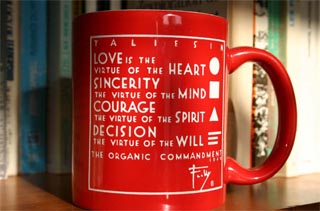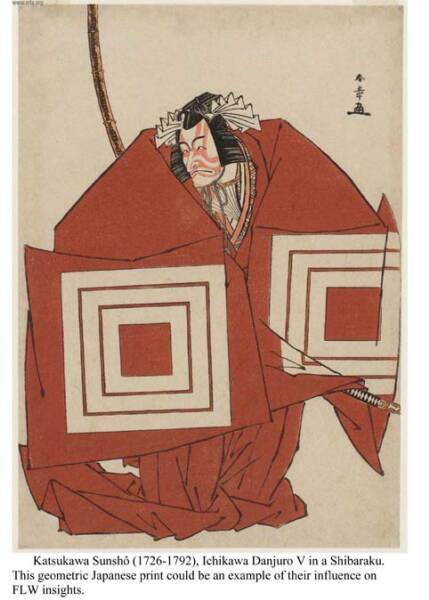THE RED CUP STORY
By Yves Jeanson,
While visiting Taliesin West in Scottsdale Arizona in autumn 2005 with my family, my daughter after the visit, had spotted a beautiful red cup for sale in the gift shop of this Fellowship which teaches the organic architecture according to the ideas of his founder, the famous American architect Frank Lloyd Wright (1867-1959). On this cup, one could read as follow four short sentences engraved in white letters (The Organic Commands. 1940): LOVE is the virtue of the HEART; SINCERETY the virtue of the MIND; COURAGE the virtue of the SPIRIT; DECISION the virtue of the WILL. At the end of each sentence, and very curiously for me, there were geometrical figures next to each ending word: to the word HEART, followed a circle; to the word MIND, followed a square; to the word SPIRIT, followed a triangle; and finally to the word WILL, followed three horizontal lines, among which the one on top longer than the two others below.
These four geometrical figures, led me to the interrogation to know if FLW had associated a meaning to those signs similar to the meaning Zanis Waldheims (1909-1993), the Montreal artist philosopher thinker I had met in 1974, had imagined in his symbolic and geometric approach to the object of knowledge in general, and philosophy in particular.
Not wanting to stay without an answer which the FLW's Organic Commandments had initiated in me, I subsequently bought books written by, or on him: (An Autobiography, 1943; and A Testament, 1957), and many others books too. While reading A Testament (Part One, The Seed, pg19), I found another reference where FLW associates a specific meaning to a specific geometrical form. One could read that:
“In outline the square was significant of integrity; the circle - infinity; the triangle - aspiration; all with which to “design” significant new forms.”
This excerpt had an impact on me just as strong as the first sighting of the figures associated to the Organic Commandments, and pushed me to continue my search to know if FLW had given an explanation or the reasons why he associated such and such a geometric form, to such and such a word, see if he had given it a universal constant.
One reading leading to another, the reading of those books introduced me into the world of FLW, his sources and ideas: Thomas Jefferson, Ralph Waldo Emerson, Henri David Thoreau, Walt Whitman, Victor Hugo, etc., and led me to discover, that he had been strongly influenced by the pedagogy of Friedrich Fröbel (1782-1852) the developer of an innovative pedagogy for childhood in Germany in the beginning of the 19th century. I also discovered, that FLW writes about the positive influence that the Froebel Gifts had on him during his childhood (geometrical forms to play with); and that FLW had adopted several ideals from Froebel : unity, wholeness, harmony, et cetera which inspired him on the long run in what was to become his wonderful organic architecture.
I was very impressed by my first phase of readings and discoveries about FLW, but I still then hadn’t found anything concluding in regards to my questioning back in October 2005: had he written on the meaning or the use of those primary forms at the end of each statement.
Once again, my daughter helped me in finding clues. While she was at Taliesin West, she bought a book in the gift shop that she sent me as a New Years present for 2006. The book on FLW, was written by the scholar David Michael Hertz, titled: Frank Lloyd Wright, In Word and Form. To my great surprise, I could read in this book, that Mister Wright had published in 1912 a book titled, The Japanese Print that I bought later.
Here is the transcription of this important paragraph from page 47 of Hertz’s book:“Although he admires the manner in which the Japanese mind eliminates unimportant detail to show the abstract form underneath objects, Wright clearly does not see geometric precision in form in a purely abstract sense. In The Japanese Print, he states clearly for the first time that forms signify meaning (“human ideas, moods, sentiments”). Forms that characterize various moments in Wright’s career are described in this brief, important text in terms of specific significations. Forms convey a kind of psychic “spell-power,” a mystical primal meaning which is continually latent in any “grammar” of forms: the square evokes “integrity,” the triangle suggests “structural unity,” the circle means “infinity,” “aspiration” is best implied by the spire, and the spiral signifies “organic progress.”
Finally, I had found from this short text in D.M.Hertz' book, what I was looking for, a solid confirmation that for FLW, forms signify meaning (“human ideas, moods, sentiments”), but above all and most importantly, in respect to my own personal experience with geometrical abstraction, I could extrapolate Hertz' insightful sentence, and attempt to explain the reasons why certain forms -more than others- signify meaning, and possibly explain FLW` insights.
In Waldheims' geometrical abstraction, words are tied to emotions, that is to say, words depending on their meaning act on man's emotions and intellect (the sensible and the intelligible). Per example the word peace can evoke calmness (consequently: extensive); the word war can evoke stress (consequently: intensity). Extensive and intensive are symbolically linked to two geometric figures to make a rational rapport that exists in the character of the geometrical figures themselves. The geometrical figures used by Waldheims are the square, the circle, the rhombus, the XY axis, and the dot. All those figures have an extent / size / area like value.
With this in mind, here is one example of Waldheims approach as an abstraction applied to a typical situation that needs understanding, where one can make a rapport with FLW's Organic Commandments figures. COSMOS means: immensity (EXTENSIVE); sign: SQUARE ; a limit, the most extensive one, because the square illustrates for the rational mind, the largest surface per unit of measure in the real world, a mathematical and geometrical certitude. ATOM means: minuscule (INTENSIVE); sign: the DOT ●; the other limit, the most intensive one, because the dot illustrates a no surface, an infinite intensity but not the void. The dot has also its mathematical and geometrical sense.
In his approach -relative to the study of the object knowledge- one has to find a word that will illustrate a position, or an element between two limits of sense expressed by the words used in the predicate. It could be words relating to nature, or the nature of the human being. Respective to the former words used in the example above, the word MAN in this context, and as an example, means a relation between two extremes; sign: RHOMBUS ◊; which is the position between the two extreme limits when conceived as being part of a whole, and a three dimensional space. Et cetera, and implicitly for many many typical situations.
We have here a tri-axial, and a three dimensional configuration of the words used in this situation, or other situations that needs comprehension. The usual approach is polar so common in philosophy, that is to say: the one or zero approach in dealing with human problems. Not only one uses words to communicate, one must harmonize the situation at stake to diminish the tensions in both extremes, especially in a situation where humans and civilization is at stake. This is geometrical abstraction of words, rather than their purely subjective meaning.
Zanis Waldheims, has worked all his life on a symbolic geometry to find a more objective, or inclusive scientific way to approach the world of thoughts and ideas expressed in writing. Waldheims’ geometrical abstraction, is a metaphor of a metaphor, even though this is perceived as an impossibility for late Wallace Stevens, the great American poet.
FLW’ architecture and ZW’ art production, finally both used a “grammar” based on geometry as an abstraction: the former applied to architecture as a science (organic); the latter as a means to structure one's thought in the complex and subjective domain of ideas that rules the world; in a world where for Goethe "one should draw more and more; write less and less."
Waldheims' means of expression is not in the domains of words, but in an original art form (his drawings and sculpture prototypes) that was developed in time, as an architecture of the mind; an architecture where the eye and reason can fusion for a better understanding of nature and man.
Those discoveries in the work of FLW got me closer to the architect, and stimulated me very much to pursue the work I had started in developing and explaining Zanis Waldheims’ geometrical abstraction and art, because I had found in FLW writing the way to express, and explain those complex ideas I had about geometry as an abstraction, compared to the Kantian / Hegelian / Husserlian approach Waldheims had used unsuccessfully in his explanations while he lived. Those ideas expressed above, are rather in an Emersonian / Wrightian world.
Finally, to what I perceive in FLW’ book -A Testament (1957)-page 110 as an existential question:
“What would be the nature of the abstraction that could be intelligently made to clarify and defend us in what we are calling "civilization"?
Zanis Waldheims would have replied: “Geometrical Abstraction. The symbolic use of geometry as an abstraction, as a means for the study and the orientation of civilization.”
Why geometry as an abstraction? Because geometry is universal, and once abstracted, it can rationally stand in front of the "subjectivism" of words on which all of our knowledge and thinking is built on; subjectivism that profits to ideologists, politicians, demagogues and religions.
Possibly, that FLW would have understood the sense of Waldheims idealism too; and would have recognized a fellowship of ideas in his artistic and philosophical work.
With this perception in mind (the Engraved Red Cup with the organic commandments and geometrical abstraction), all the drawings and buildings, and inside decoration from FLW work, have become of an easy reading for me. The stained glass windows, the ceiling lights, the geometric rugs, the houses, the buildings, the museums, the churches he built, etcetera, have a dimensional sense and a poetical meaning. I can now interpret many of these beautiful designs, drawn from simple geometrical figures, such as squares (mind); circles (heart); triangles (spirit); and lines (will) or the combinations of all of those figures in one drawing or building. I don’t see only a building, but a organic poem.
With -geometrical abstraction- we are one step further in human intelligence and global consciousness.
As FLW said, everything is a matter of Perception.
-END-Montreal, July 2009.
Yves Jeanson on Frank Lloyd Wright's Oeuvre


